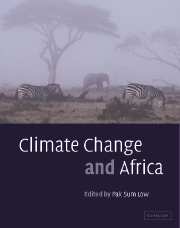Book contents
- Frontmatter
- Contents
- Notes on contributors
- Peer reviewers
- Editor's note
- Foreword
- Foreword
- Foreword
- Foreword
- Preface
- Preface
- Preface
- Preface
- List of abbreviations
- List of SI prefixes
- List of unit abbreviations
- List of chemical formulae
- Part I Science
- Part II Sustainable energy development, mitigation and policy
- 10 Biomass energy in sub-Saharan Africa
- 11 Natural resources: population growth and sustainable development in Africa
- 12 Sustainable energy development and the Clean Development Mechanism: African priorities
- 13 Opportunities for clean energy in the SADC under the UNFCCC: the case for the electricity and transport sectors
- 14 Regional approaches to global climate change policy in sub-Saharan Africa
- 15 Energy for development: solar home systems in Africa and global carbon emissions
- 16 Climate change in sub-Saharan Africa: assumptions, realities and future investments
- 17 Climate-friendly energy policies for Egypt's sustainable development
- Part III Vulnerability and adaptation
- Part IV Capacity-building
- Part V Lessons from the Montreal Protocol
- Index
11 - Natural resources: population growth and sustainable development in Africa
Published online by Cambridge University Press: 10 December 2009
- Frontmatter
- Contents
- Notes on contributors
- Peer reviewers
- Editor's note
- Foreword
- Foreword
- Foreword
- Foreword
- Preface
- Preface
- Preface
- Preface
- List of abbreviations
- List of SI prefixes
- List of unit abbreviations
- List of chemical formulae
- Part I Science
- Part II Sustainable energy development, mitigation and policy
- 10 Biomass energy in sub-Saharan Africa
- 11 Natural resources: population growth and sustainable development in Africa
- 12 Sustainable energy development and the Clean Development Mechanism: African priorities
- 13 Opportunities for clean energy in the SADC under the UNFCCC: the case for the electricity and transport sectors
- 14 Regional approaches to global climate change policy in sub-Saharan Africa
- 15 Energy for development: solar home systems in Africa and global carbon emissions
- 16 Climate change in sub-Saharan Africa: assumptions, realities and future investments
- 17 Climate-friendly energy policies for Egypt's sustainable development
- Part III Vulnerability and adaptation
- Part IV Capacity-building
- Part V Lessons from the Montreal Protocol
- Index
Summary
Keywords
Africa; population pressure and land resources; environmental degradation; productivity; natural resources; sustainable development
Abstarct
The nexus between population growth and the demand for agricultural land in the different regions of Africa is examined. Given present trends, the demand for agricultural land may increase by about 75% in 2025 and by more than threefold when Africa's population stabilizes after 2100. A comparison is made between the past demand for agricultural land and the decrease in forest area. In most regions of Africa, there is a close correlation between these two factors. Therefore, without active intervention, the future enlarged agricultural estate will be at the expense of high forests and woodlands. By the time the population stabilizes, Africa could lose half its forests. At present, there is a surplus of wood compared to demand, and this surplus could be used to expand rural opportunities. However, in nearly every country there are pockets of shortages. These pockets will expand if little is done to improve agricultural and silvicultural productivity. Ways of improving productivity are discussed, especially with farm trees; this will release the pressure on forest areas. Also, strategies for meeting demand in wood deficit areas are specified. Land-use change targets are given based on various productivity assumptions and increased food intakes. If the forecasted gains are made, coupled with the expanded use of renewable resources, then the demand for extra farmland may increase by only one-third by 2025 and by one-half when the population stabilizes.
- Type
- Chapter
- Information
- Climate Change and Africa , pp. 113 - 123Publisher: Cambridge University PressPrint publication year: 2005
- 2
- Cited by

